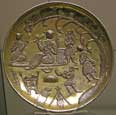

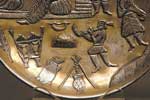


Iran, Tabaristan (SE of Caspian Sea), 8th c. CE. Silver with gilding. Dia.: 19.7 cm.
Pahlavi (Middle Persian) inscription: "Anushzad." Masked figure in upper right suggests a Zoroastrian ritual. As BM website points out, the designer "mis-understood" some of the Sasanian iconography on which this is based.
OA 1963.12.10.3.
Black and White photo from I. I. Smirnov, Vostochnoe serebro (St. Petersburg, 1909).
Learn more.
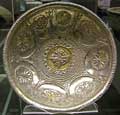
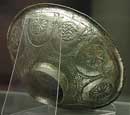
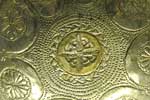

Iran, Khurasan, ca 800 CE. Found at Susa (?). Silver-gilt.
ME OA 1881.3-5.1
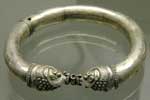
Iran, 9th-10th c. CE. Silver.
Sasanian form but method of fastening is from later period.
OA 1937.1-9.1, 2


Iraq or Iran, ca. 9th c. CE. Cast brass.
The form is from Classical antiquity but was common in Sasanian art (especially with the senmurv motif).
OA 1959.10-23.1
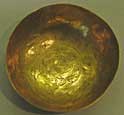

Western Iran. Nihavand Hoard (found near Hamadan). 11th-12th c. CE. Probably belonged to Abu Shuja Inju Takin al-Hajob (the Gatekeeper), a Seljuk official, whose name is on a belt buckle from the same hoard. Gold, inscribed around rim with kufic inscription in praise of wine.
OA 1938.11-12.1
Learn more.
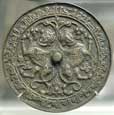
Eastern Anatolia or Northern Iraq. 11th-13th c. CE. Cast bronze.
ME OA 1866.12-29.78
Compare similar examples: Louvre OA 3945; State Historical Museum (Moscow) (example found in Volga Bulgaria); LACMA M.2002.1.611.

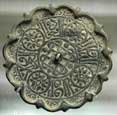

Iran (?), 11th-13th c. CE. Cast bronze.
ME OA 1866.12-29.75; 1964.2-12.1; +1344


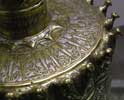
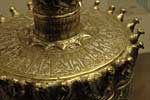
Afghanistan, Herat. 1180-1200 CE. Sheet brass inlaid with copper, silver and gold and with repoussé decoration including signs of the zodiac. H.: 40 cm.
OA 1848.-8-5.2
Learn more.


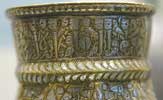
Afghanistan, Herat. ca. 1200 CE. Sheet brass inlaid with silver and gold and with incised decoration. The letters of the inscription terminate with human heads, monkeys and birds; snakes are wrapped around shafts of letters.
OA 1885.7-11.1
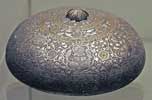
Iran, Khurasan. Late 12th-13th c. CE. Brass inlaid with silver.
1891.6-17.8


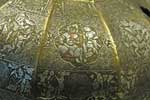
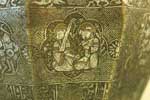



Iraq, Mosul. AH 629/CE 1232. Brass inlaid with copper and silver and engraved with courtly images including in lower part scenes of Bahram Gur and his lover Azade from the Shahnama. H.: 30.4 cm.
Signed by Shuja' ibn Man'a al-Mawsuli, AH Rajab 629/CE May 1232. ME OA 1866.12-29.61.
Learn more.


The Jazira or W. Iran. 13th c. CE. Brass inlaid with silver and gold.
An Armenian inscription dedicates it to the Church of St. Mary, possibly located in Mosul.
OA 1881.1-27.1



Syria or The Jazira. ca. 1200-1250 CE. Brass inlaid with silver, engraved with Christian imagery.
OA 1873.12-30.679


Egy;t or Syria. ca. 1300-1350 CE. Brass inlaid with silver and gold, engraved with Arabic blessings to an unknown emir.
OA 1878.12-30.680






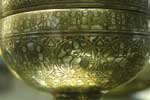
Khurasan, possibly Herat (Afghanistan), ca. 1200 CE. High tin bronze (bell metal) inlaid with silver and engraved with signs of zodiac, planets, huntsmen, etc. The lid is not original to the bowl. H.: 21.5 cm.
OA 1950.7-25.1
Learn more. Compare Louvre MAO 1220, which has a lengthy description of that object, apparently complete with its original cover. The Louvre example is dated to ca. 1220, immediately after the Mongol invasion of Khurasan.
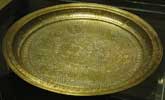
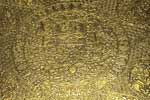
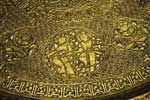
W. Iran, late 13 c. CE. The style reflects Mosul area metalwork of earlier 13th c., but size and composition point to Mongol patronage. Brass inlaid with silver and gold.




Iran, Fars, 14th c. CE. Brass inlaid with silver.
OA 1901.6-6.3
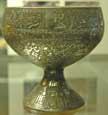
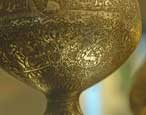
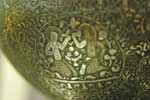
Iran, 14th c. CE. High tin bronze (bell metal), inlaid with silver.
OA 91.6-23.4

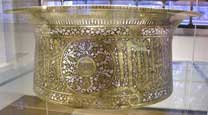
Egypt (Cairo) or Syria (Damascus). Brass inlaid with silver and gold. H. 22.7 cm.; dia.: 54 cm.
ME OA 1851.1-4.1
Learn more. An analogous basin is the famous "Baptistery of St. Louis," in the Louvre, Inv. no. LP 16.

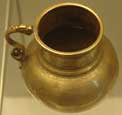

Afghanistan, Herat, late 15th c. CE. Brass.
OA 1978.12-30.730
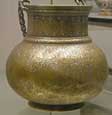
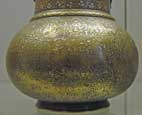
Herat, Sha'ban 903 AH/april 1498 CE. Brass inlaid with gold and silver. The lid and handle are missing. H. 12.9 cm.
Inscription lauds Timurid ruler Husayn Bayqara (1470-1506), a noteworthy patron of the arts. The maker was Muhammad b. Shamsi (Shams al-Din) al-Ghuri. OA 1962.7-18.1
Similar tankards are in the collections of the Victoria and Albert Museum, in the Museum für Islamische Kunst in Berlin and in the Louvre.
Learn more.

Afghanistan, Herat. AH 889/CE 1484-1485. Brass inlaid with silver and gold and engraved with arabesques and an inscription.
Signed by Jamal al-Din b. Shams al-Din.
OA 1965.6-20.1
Compare: Victoria and Albert Museum 943-1886; Louvre Inv. no. MAO 697.